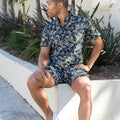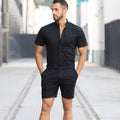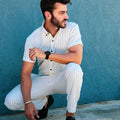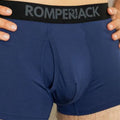Have you ever noticed how slipping into that favorite navy shirt instantly makes you feel more confident? Your clothes are having conversations before you even open your mouth. The colors hanging in your closet might be telling stories about you that are louder than you think.
There's actual science behind why certain outfits make us feel unstoppable while others leave us feeling flat. Color influences mood, trust, and even how people make decisions about us. Here's something fascinating: researchers at a U.S. Naval Correctional Center painted a holding cell pink and watched inmate violence drop to zero during initial confinement. Pretty powerful stuff, right?
This same color magic works with your wardrobe too. When you throw on that navy blue shirt - and you're in good company since about 18% of men choose navy as their go-to color - you're not just getting dressed. You're feeling calmer and more confident while everyone around you sees you as trustworthy and reliable.
Your suit isn't just fabric and thread - it's a communication tool that shapes how the world sees you. Whether you're reaching for black to command respect or selecting navy to project dependability, your clothing colors are working overtime to send specific messages about who you are.
Ready to decode what your wardrobe is really saying? We're going to explore the hidden messages in your color choices, discover how different shades affect both your mood and others' perceptions of you, and learn how to use color psychology to build a wardrobe that works as hard as you do. Let's dive into the colorful world of fashion psychology!
The Basics of Color Psychology in Clothing
Color affects us in ways that go far beyond just looking good. Color psychology examines how different shades influence our mood, behavior, and emotions. This field dives deep into what colors actually mean, how they trigger physical responses, and why people from different cultures might have completely different reactions to the same hue.
What is color psychology?
Think of color psychology as a silent conversation happening around you all the time. Goethe was one of the first to suggest that colors carry emotional weight, and since then, this field has grown into a fascinating mix of art, science, and human behavior research. When it comes to fashion, color psychology goes beyond just choosing what looks nice—it's about understanding how colors make you feel and how they shape what others think about you. This same understanding has been helping marketers, advertisers, and interior designers influence people's decisions for decades.
How clothing colors affect perception
Every outfit you put together starts a conversation before you've said a single word. Studies show that teachers' assistants who dress more formally get perceived as more intelligent. Similarly, women who choose more masculine clothing styles for job interviews have better luck landing managerial positions in banking and marketing.
Different colors send distinct signals to everyone around you:
· Light colors make you appear more friendly, honest, and easy to approach
· Dark colors project dominance, authority, and a formal vibe
· Muted colors come across as less threatening and more conservative
· Bright colors communicate confidence and high energy
The link between mood and wardrobe
Here's where things get really interesting: your clothes don't just communicate with others—they have a direct line to your own brain too. Researchers Adams and Galinsky discovered something they call "enclothed cognition". People wearing white lab coats made half as many mistakes on mental tasks compared to those in regular clothes. Pretty amazing what a simple piece of clothing can do for your performance!
Cultural background plays a huge role in how we respond to colors emotionally. A 2004 study by Kaya and Epps found that colors like blue and green typically make people feel calm and happy, while red and black tend to stir up more intense emotions. Generally speaking, lighter shades produce more positive feelings than darker ones.
But here's the thing—these color associations aren't set in stone everywhere. Red means prosperity and purity for brides in India, while Western cultures often link it to passion and power. Understanding how color psychology works personally for you means you can build a wardrobe that truly reflects who you are and helps you feel your best.
What Your Favorite Clothing Colors Say About You
Ever wonder why you keep reaching for that same color over and over? Your closet choices aren't accidents - they reveal deeper aspects of your personality and send specific messages about who you are. The colors we're drawn to speak volumes about how we see ourselves and how we want others to see us.
Navy and Gray: The Trustworthy Professionals
If navy and gray dominate your wardrobe, you're in excellent company with the reliability crowd. About 18% of men choose navy as their go-to color, and there's a good reason why. When you slip on that navy shirt, you instantly feel calmer and more confident, while everyone around you picks up on your trustworthiness and dependability.
Gray lovers - roughly 15% of men - tend to feel balanced and grounded in their charcoal pieces. Others see you as intelligent and mature, which makes gray a fantastic choice for important meetings or first impressions. These colors work like wardrobe workhorses, pairing beautifully with almost everything you own.
Black and White: Power Meets Simplicity
Black clothing speaks to the ambitious soul. Around 10% of men prefer black, and if you're one of them, you probably love how it makes you feel sophisticated and mysterious. People drawn to black are often purposeful and driven, though surprisingly sensitive underneath that strong exterior.
White enthusiasts - about 12% of men - connect with feelings of cleanliness and optimism. When you wear white, you're communicating honesty and straightforwardness to the world. Those who favor white are typically seen as organized and detail-oriented. Remember, both black and white make bold statements in completely different ways.
Red and Pink: Bold Confidence and Modern Warmth
Red wearers are the confident risk-takers. Only about 6% of men choose red regularly, but when they do, they feel energetic and bold while appearing assertive and commanding. There's something undeniably powerful about red that makes you feel noticed and in control.
Pink might surprise you - about 2% of men are embracing this color, and they're onto something special. Pink helps you feel empathetic and modern while projecting warmth and emotional intelligence. Don't shy away from pink if it calls to you - its association with nurturing and calmness creates wonderfully open, lighthearted interactions.
Green and Brown: The Nature-Connected Stability Seekers
Green connects you to something deeper - feelings of groundedness and adventure while projecting dependability to others. It's amazing how this color can sustain good moods and bring peace through its natural associations. If green speaks to you, you probably value harmony and growth.
Brown lovers, around 7% of men, create feelings of stability and reliability wherever they go. People see brown wearers as warm, safe, and honest. Those drawn to these earthy tones often value tradition and seek balance in their lives - there's wisdom in connecting with these grounding colors.
Blue and Light Blue: The Peaceful and Approachable
Blue wins the popularity contest as the most chosen color overall, and it reflects a deep need for personal peace. When you wear blue, you feel relaxed while appearing calm and dependable to everyone you meet. Here's something fascinating: studies from the University of British Columbia found that darker blues can actually increase calming hormones like oxytocin.
Light blue fans - about 5% of men - tap into feelings of kindness and approachability. If you want to seem more friendly and accessible, light blue is your secret weapon.
Yellow and Orange: The Optimistic Energy Boosters
Yellow projects pure happiness and optimism. Those who wear it feel vibrant and energetic while appearing enthusiastic and bold to others. People drawn to yellow are often naturally creative and outgoing. Don't be afraid to experiment with yellow if you want to brighten your mood and everyone else's!
Orange wearers - around 2% of men - feel playful and adventurous while appearing sociable and energetic. Research shows orange grabs attention effectively while still feeling friendly and approachable. Consider orange when you want to stand out in the best possible way.
Purple and Teal: The Creative Individualists
Purple lovers tend to be sensitive, compassionate, understanding, and supportive. This color represents wisdom, creativity, and spirituality. There's something magnetic about purple that draws people to your charismatic energy.
Teal enthusiasts - about 2% of men - create feelings of sophisticated modern balance while projecting innovation and tasteful confidence. Both purple and teal appeal to those seeking to express their individuality - perfect choices when you want to showcase your unique perspective.
Remember, these color preferences reveal aspects of your personality, but they also give you tools to project the image you want. Whether you're naturally drawn to trustworthy navy or adventurous orange, understanding what your colors communicate helps you dress with intention and confidence.
Using Color Theory to Build a Better Wardrobe
Dressing well isn't just about having good taste - it's about understanding the science of color. Color theory can help you create outfits that not only look great together but also complement your personal style and complexion.
Understanding the Color Wheel
Think of the color wheel as your style roadmap for putting together killer outfits. Sir Isaac Newton developed this handy tool back in 1704, and it's still your best friend for color coordination. The basics are pretty simple: you've got three primary colors - red, yellow, and blue - that can't be created by mixing other colors. Mix these together and you get secondary colors like orange, green, and purple. Keep mixing primary and secondary colors, and you'll create tertiary colors such as yellow-orange, red-purple, and blue-green.
Complementary vs Analogous Combinations
Here's where things get interesting! Complementary colors sit directly across from each other on the wheel - think red and green or blue and orange. These create bold contrasts that really make each color pop. Want to use this in your outfit? Let one color dominate while the other provides an accent.
Analogous colors are neighbors on the wheel, creating smooth, harmonious looks. Colors like blue, blue-green, and green blend beautifully together, just like you'd see in nature. For the best results with these combinations, try the 60/30/10 rule - 60% dominant color, 30% secondary color, and 10% accent color.
Monochromatic Outfits and When to Use Them
Monochromatic dressing uses different shades of the same color to create a sleek, polished appearance. Here's a bonus: this approach actually makes you look taller since there's no color break interrupting the visual flow. The key is mixing different textures and fabrics within the same color family to add depth and interest. This style works particularly well with neutrals and muted tones.
Creating a Balanced Color Palette for Your Wardrobe
Building a smart wardrobe color palette is like creating a solid foundation for your style. Here's what you need:
· Neutrals: Black, white, gray, navy, and beige are your foundation pieces
· Complementary colors: Softer versions of bright colors that work as versatile base pieces
· Accent colors: Bold hues that add personality and make your outfits stand out
· Metallics: The finishing touches that elevate your overall look
Remember, you want more neutrals and complementary colors than accent pieces. This balance gives you maximum versatility and endless outfit possibilities. Consider your lifestyle and the occasions you dress for when building your palette - it should work for your real life, not just look good in theory!
Dressing with Intention: Matching Color to Occasion
Smart color choices can make the difference between blending in and standing out for all the right reasons. Knowing when to reach for specific colors can boost your impact in any situation.
Work and formal settings
Professional environments call for colors that build trust and respect. Navy, black, gray, and white create that foundation of competence everyone's looking for in the workplace. Corporate settings thrive on these conservative neutrals. Banking and financial professionals especially love blue because it screams credibility.
Remember, though, industry culture matters. Healthcare workers might sport colorful scrubs, but that traditional white coat still represents expertise and authority. Consider your workplace vibe before experimenting with bolder choices.
Casual and weekend wear
Weekend wardrobes are where you can really have some fun! Casual settings welcome those earthy tones like beige, mustard, and olive green that create a natural, approachable feel. Denim works like magic as your neutral base - throw on a boldly colored top and you're golden.
For those bright summer weekends, cheerful combinations like yellow and white create a light, memorable look that's hard to forget. Don't be afraid to play with colors that make you smile!
First impressions and social events
First impressions happen fast, so your color choices need to work immediately. When you're networking, think about your audience - are they traditional corporate types or creative innovators?
Formal occasions call for sophisticated deep tones like burgundy, emerald, and chocolate brown. Context is everything here. That bright orange blazer might showcase your creative flair at an art gallery opening, but it could hurt your credibility in a conservative business setting.
How to use accessories to add color
Accessories are your secret weapon for adding color without commitment. A vibrant scarf, bold watch, or colorful shoes can instantly elevate your look without requiring a complete wardrobe makeover.
Here's a simple strategy that works every time: keep your base outfit neutral, then add one strategic pop of color through accessories. This technique shines with contrasting colors - picture a black outfit with red shoes and a matching belt. That creates dynamic visual interest that people remember.
Remember, confidence is key when experimenting with color combinations. Start small with accessories, then work your way up to bolder choices as you discover what feels authentically you.
Conclusion
Your closet is more than just a collection of clothes - it's your personal communication center working around the clock. We've explored how navy blue builds trust, black commands authority, and red radiates confidence. These aren't just fashion tips; they're tools for strategic self-presentation.
Color theory isn't about following rigid rules or looking like everyone else. The science behind complementary, analogous, and monochromatic combinations gives you a framework to express yourself with intention. Your clothing colors are constantly speaking for you, whether you realize it or not.
Think about it: when you grab that black shirt before your big presentation or pick that bright yellow polo for Saturday brunch, you're not just choosing what looks good. You're making decisions that influence how you feel and how others respond to you.
Your wardrobe is essentially a psychological toolkit. Each color has a job to do - building trust in boardroom meetings, showcasing creativity at casual gatherings, or creating unforgettable first impressions at networking events.
Here's what matters most: stay true to yourself. Understanding these color psychology principles helps you dress with purpose, but the colors that make you feel genuinely confident will always serve you best. Don't force yourself into colors that don't feel right just because they're "supposed" to work.
Remember, confidence is your best accessory. When you understand the psychology behind your color choices and pick shades that align with both your goals and your authentic self, you're creating a powerful combination. Your wardrobe becomes a reflection of who you are and who you're becoming - and that's when the real magic happens.
So go ahead, open that closet with a new perspective. You've got the knowledge to make every color choice count!







